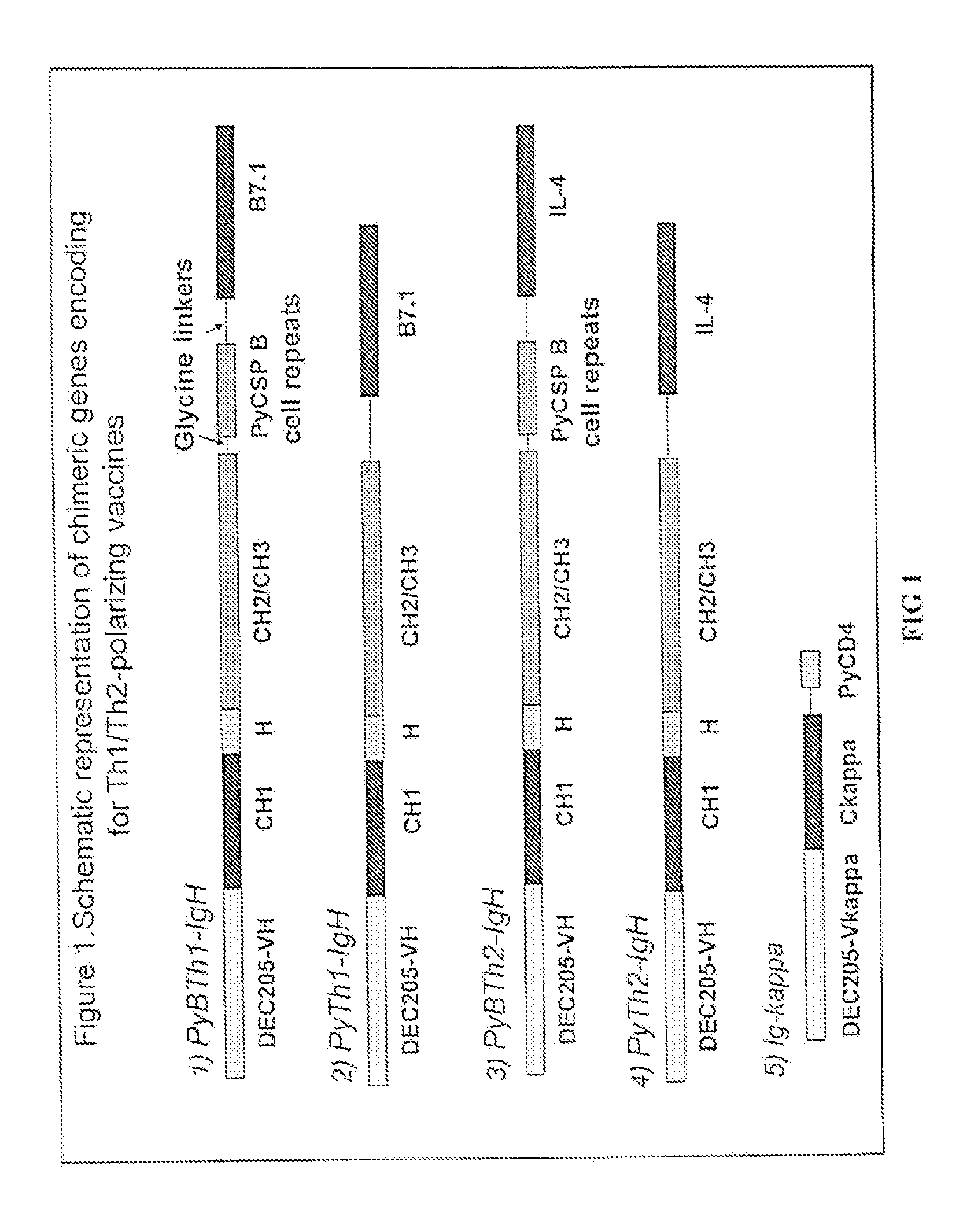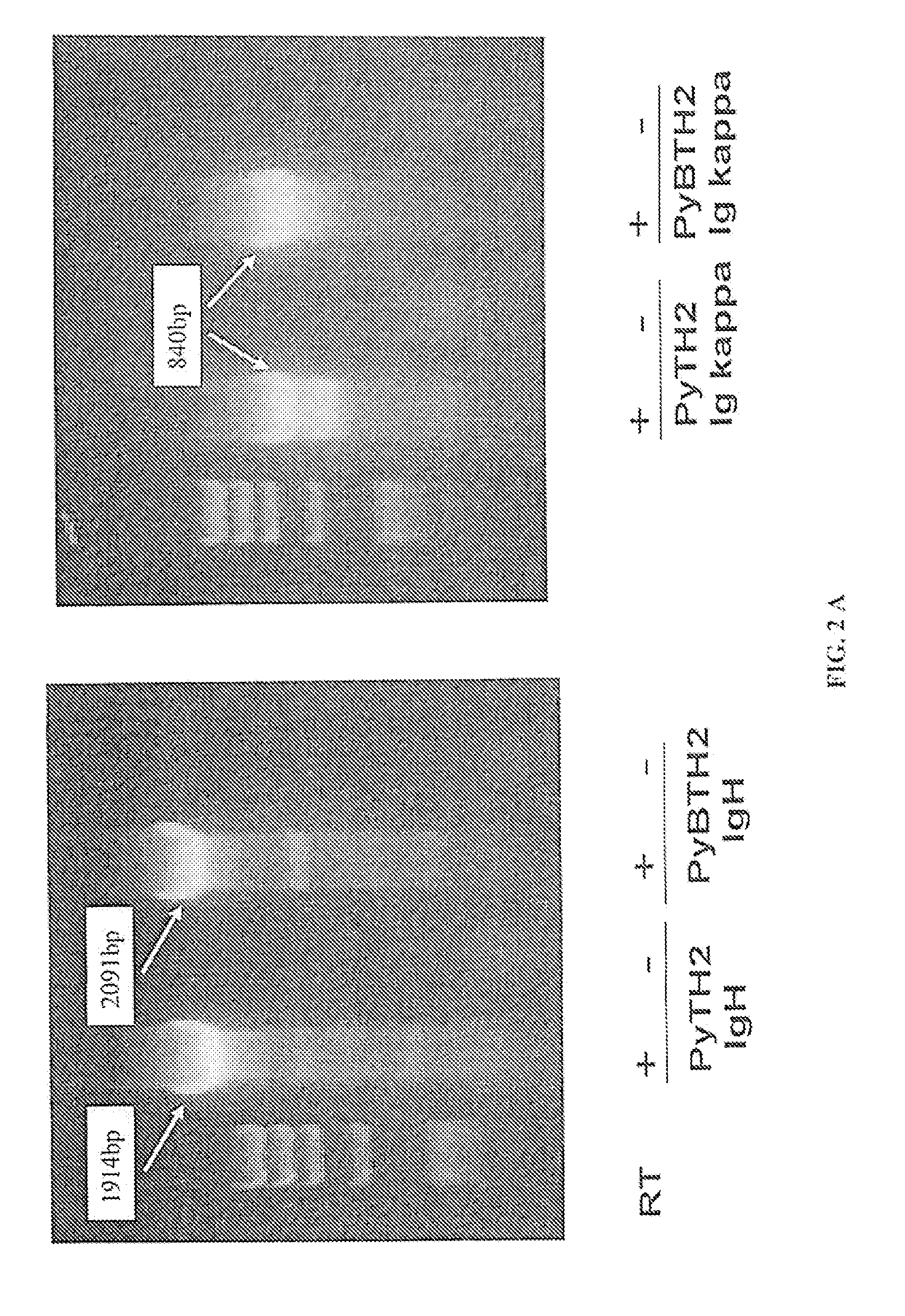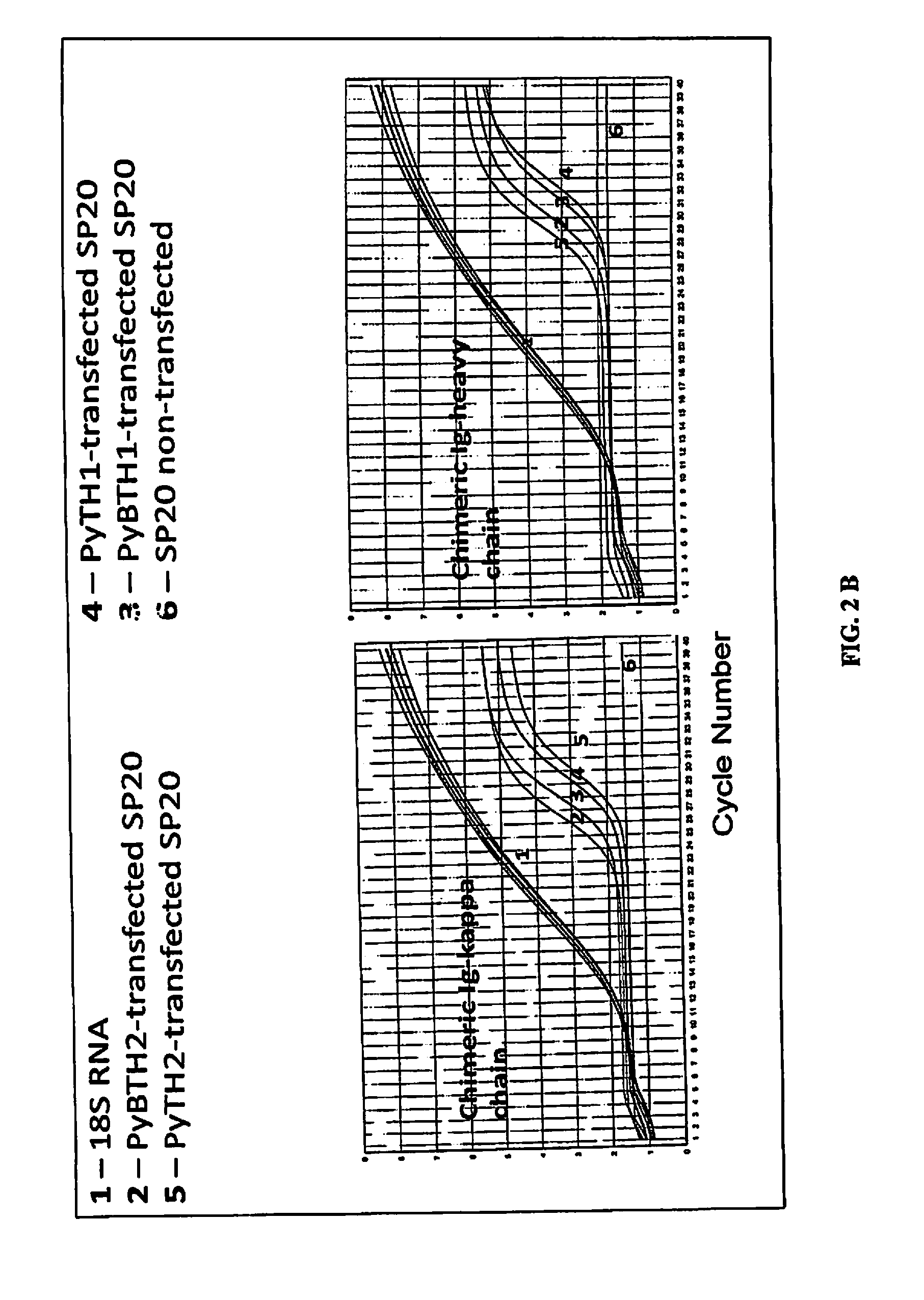TH1/TH2 polarizing vaccines
a polarizing vaccine and chimeric technology, applied in the field of recombinant chimeric molecules, can solve the problems of limited success, confounded cycle efforts to develop efficacious vaccines, and particularly disappointing dna plasmid vaccines
- Summary
- Abstract
- Description
- Claims
- Application Information
AI Technical Summary
Problems solved by technology
Method used
Image
Examples
example 1
Genetic construction of Chimeric Ig-H and Ig-Kappa Genes
[0043]Four chimeric molecules were made using genetic engineering techniques, and are separately designated as PyTh1, PyBTh1, PyTh2 and PyBTh2. Each chimera vaccine molecule is encoded by two genes. One gene encodes a specific heavy chain of the immunoglobulin (Ig-H gene) of each vaccine molecule. A second gene encodes the Kappa light chain of the immunoglobulin, which is common among the four chimeric molecules (Ig-kappa gene). Genetic sequences encoding the Ig-H of each chimeric molecule were shown in Table 1.
[0044]As shown in FIG. 1 (1) and (3), the chimeric Ig-H genes of PyBTh1 and PyBTh2 contain regions encode for the variable region of rat anti-mouse DEC205 (VH), mouse IgG2a components (CH1, hinge, CH2 and CH3), PyCSP B cell repeats [QGPGAP]4[QQPP]5 and a T cell costimulatory ligand. The T cell costimulatory ligand is B7.1 for chimeric molecule PyBTh1 or IL-4 for chimeric molecule PyBTh2.
[0045]As shown in FIG. 1 (2) and (...
example 2
Expression of the Chimeric Th1 / Th2 Genes in Stably Transfected Myeloma SP20 Cells
[0048]The plasmids encoding for the chimeric Ig-H and Ig-k genes were doubly transfected into mouse myeloma SP20 cells. Stable transfectants were selected by resistance to G418 and zeocin. To rule out amplification of plasmid DNA, some samples were subjected to retrotranscription (RD and then amplified by PCR using specific primers set forth in table 2.
TABLE 2PrimersSEQ IDPrimersNo.Th1-Fgl-F: GCACTGAAGCTTGTCCTGATTGCCTCAGCCTTC6Th1-Fgl-R: CAGTGGGTATACCGATGGGGCTGTTGTTTTGGCTGAGGAGACTGTGACCAT7Th1-Fg2-F: CCATCGGTATACCCACTGGCCCCTG8CH1-R: GATTGTGGGCCCTCTGGGCTCAATTTTC9IgG2aFc-F: CAGAGGGCCCACAATCAAGCCCTGTCCTCCA10PyB-F: AGGGCCCCGGGGCGCCCCAAGAGCCGCCACAGCAACCCCCACAACAGCCTCC11GCAACAACCACCGCAGCAGCCCCCTGGAGGTGGTGGATCCGGTGGAGPyB-1R: CCCCTGTGGTGCCCCTGGGCTTGACCGCCTCCCCCTCCACCACCTCCTTTAC12CCGGAGTCCGGGAGPyB-2R (new): GCGCCCCGGGTCCCTGAGGAGCACCCGGTCCTTGTGGGGCACCAGGCCCCTG13TGGTGCCCCT GGGCCTTGACCGCCTCCB7.1-F: GGTGGTGGATCCGGTGGA...
example 3
Immunocharacterization of Th1 / Th2-Polarizing Vaccines
[0050]The plasmid of the TH1 / Th2 chimeric vaccines were purified from cell culture supernatants of plasmid-transfected SP20 cells by affinity-chromatography using anti-mouse IgG columns. Silver stain gels show the molecular size of the Th1 / Th2 vaccines in denaturing condition (FIG. 3A, left panel) are approximately 195 kDa. Upon reducing condition, the chimeric Ig-H and Ig-kappa components of the vaccines showed a molecular size of approximately 75 and 25 kDa, respectively (FIG. 3A, right panel). As reference, the molecular size of mouse IgM is also shown.
[0051]The chimeric vaccines were recognized by antibodies specific for the Ig constant domain, PyCSP B cell repeats, and costimulatory ligands, as revealed by western blot analysis (FIG. 3 B-D). Western blotting result of the chimeric vaccine molecules using anti-mouse IgG heavy chain was shown in FIG. 3B. The integrity of the chimeric Ig-H component of the vaccines was observed....
PUM
| Property | Measurement | Unit |
|---|---|---|
| Composition | aaaaa | aaaaa |
| Immunogenicity | aaaaa | aaaaa |
Abstract
Description
Claims
Application Information
 Login to View More
Login to View More - R&D
- Intellectual Property
- Life Sciences
- Materials
- Tech Scout
- Unparalleled Data Quality
- Higher Quality Content
- 60% Fewer Hallucinations
Browse by: Latest US Patents, China's latest patents, Technical Efficacy Thesaurus, Application Domain, Technology Topic, Popular Technical Reports.
© 2025 PatSnap. All rights reserved.Legal|Privacy policy|Modern Slavery Act Transparency Statement|Sitemap|About US| Contact US: help@patsnap.com



